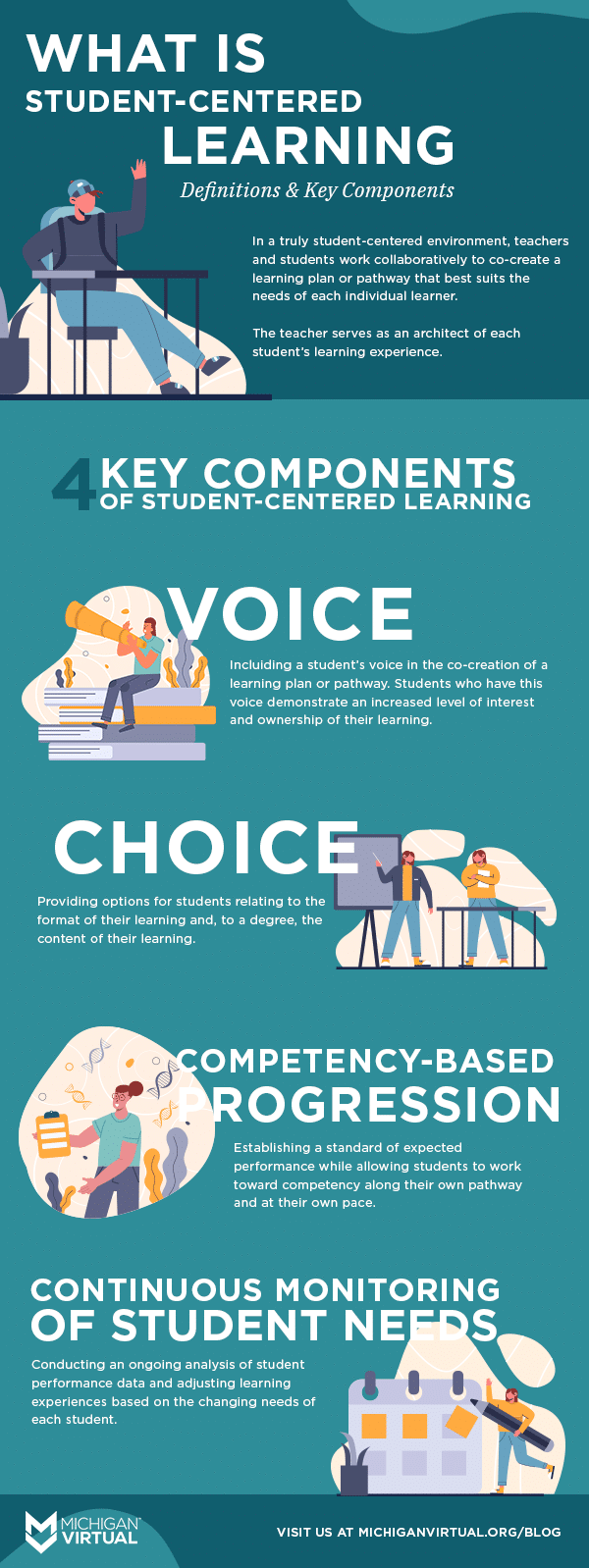Last spring, with little or no time to prepare, teachers transitioned to teaching online—an environment in which many had little or no prior teaching experience.
And some students discovered they didn’t know how to learn outside of the classroom or without direct instruction from their teachers.
Whether your school is starting the year with in-person instruction, using a hybrid model, or teaching completely online, you will need to be flexible. You may even be asked to shift back and forth between different models of instruction throughout the school year.
As we wrap up our Student-Centered Learning blog series, this is the second post of four in our mini-series, Engage and Empower Learners: How Student-Centered Learning Supports Learning Continuity. In this mini-series, we discuss how adopting student-centered learning principles can actually help school leaders and teachers facilitate the transition to this “new normal” of teaching and learning while still nurturing student growth.
In this post, we will be revisiting a core tenet of student-centered learning: competency-based progression. We will explore this concept in more depth to understand why implementing student-centered principles into the learning environment can improve student engagement and make teaching and learning, no matter what environment you and your students find yourselves in, more student-focused.

What is competency-based progression?
As we discussed in the first post of our student-centered learning blog series, one of the core characteristics of a student-centered learning environment is competency-based progression—the academic progression of students based on the demonstration of mastery or competence of predetermined standards.
In a competency-based classroom, students don’t move onto the next topic until they have demonstrated mastery of the previous topic.
In 2019, Competency Works, an initiative of the Aurora Institute (formerly iNACOL), revised their previous working definition of competency-based education. Their revised 2019 definition of competency-based education is as follows:
- Students are empowered daily to make important decisions about their learning experiences, how they will create and apply knowledge, and how they will demonstrate their learning.
- Assessment is a meaningful, positive, and empowering learning experience for students that yields timely, relevant, and actionable evidence.
- Students receive timely, differentiated support based on their individual learning needs.
- Students progress based on evidence of mastery, not seat time.
- Students learn actively using different pathways and varied pacing.
- Strategies to ensure equity for all students are embedded in the culture, structure, and pedagogy of schools and education systems.
- Rigorous, common expectations for learning (knowledge, skills, and dispositions) are explicit, transparent, measurable, and transferable.
The Aurora Institute emphasizes that in a truly competency-based environment, all seven elements should be implemented and that strong implementation requires “policies, pedagogy, structures, and culture that support every student in developing essential knowledge, skills, and dispositions.”
Now that we understand what competency-based learning is, let’s make sure we understand what it is not.
Relationship to other teaching pedagogies
Differentiated instruction
With differentiated instruction, teachers focus on collecting student data and then based on that data, sorting students into different groups. These groups are then given different supports or modifications of the same lesson or assignment.
The class typically still progresses together at the same pace, with different groups of students receiving different support.
Differentiated instruction can support a competency-based approach; however, it is still very teacher-led in terms of teachers deciding whether or not to slow down or speed up the lesson or unit based on the overall needs of the class.
Blended learning and personalized learning
Both blended and personalized learning are delivery models that school districts may use to support competency-based learning.
Blended learning is a format or a method of learning which combines traditional face-to-face instruction with online experiences that work together as an integrated experience for students. Models include Station Rotation, Flipped Classroom, and Enriched Virtual, among others.
With a personalized learning approach, students have some degree of control over their curricular pacing and learning pathways towards achieving standards.
While blended and personalized learning can support a competency-based progression, it is more than flexible pacing, differentiated support, or a combination of face-to-face and online learning.
Competency-based learning is a deeper change rooted in a system designed to support student mastery and success.
Empowering learners and supporting learning continuity
In schools designed with a competency-based model, digital learning is a common practice for students, and technology helps teachers manage the process of managing competency-based learning progressions.
Some learning management systems are actually designed to adaptively release content as students demonstrate mastery of the previous learning objectives and standards. When courses are built this way, students are truly allowed to be in the driver’s seat.
Self-paced content progressions foster student agency and ownership of learning.
In a competency-based learning environment, students are not as dependent on the teacher to disseminate information and provide directions. Learning experiences are designed so that students can progress at their own pace based on demonstrated competencies.
In a competency-based learning environment, students are used to utilizing voice and choice to shape their learning pathways and to demonstrate their understanding of the content. So when students need to learn at home because of extended school closures, their learning is far less disrupted than a student functioning in a more traditional school environment.
In a previous blog, superintendent of Fraser Public Schools, Carrie Wozniak, explained how this was the case for their teachers during Fraser’s transition to remote learning caused by the COVID-19 pandemic.
“We have a digital ecosystem. For us to shift to fully remote learning, we only had to shift slightly, modifying content somewhat as we already had the infrastructure and protocols in place to support remote learning. Our teachers already had their curricular resources in our LMS, so when we went fully remote, it wasn’t a lot of work, actually. Being student-centered already, we simply stayed focused on student learning instead of figuring out how to teach remotely. This allowed our teachers to focus more on learning, than emergency remote teaching. They didn’t need to entirely shift their focus.”
When learning is designed to be student-centered—competency-based, personalized, and flexible in terms of pace and place—learning is not limited to being teacher-led in a classroom.
Challenges and opportunities
Just as students need to have agency—to be active participants in their education, taking responsibility for their learning, and being given some degree of control in the process—teachers need to have agency, as well.
Teachers need to be empowered to make critical decisions about their students and their learning on a daily basis. They need to be provided with a system of support and professional development to help them feel knowledgeable and confident enough to transition their way of thinking. To empower their students, teachers need an organization that is empowered.
A true competency-based approach requires deep and widespread change.
Paradigm shift
Transitioning to teaching with competency-based progression may require you to break your own paradigm of what you know and believe education to be.
The education model that I grew up in was not competency-based. It was based on seat time. As a class, we progressed through the lessons and units together, at the same time.
The teacher preparation program that I went through was not competency-based either. I learned how to design lessons and assessments—the traditional whole-class “teach, memorize, test” fixed mindset.
So I’m not surprised that many teachers, myself included, do not know how to teach with a mastery-based approach to learning.
In hindsight, I learned how to be a good teacher in terms of the content and covering it efficiently. However, I wish I had learned more about how to design learning opportunities that would ensure all of my students not only learned the content but had the flexibility to go at their own pace and with the specific support that they needed.
Competency-based learning may require a deeply rooted shift in our mindset and our values as we consider what we know about education and what we believe it should be.
Opportunities
Perhaps right now—during a time where things in education are anything but traditional—is the perfect time to experiment with competency-based learning.
Many teachers are not delivering synchronous (real-time, live) daily lessons. Instead, they are providing a lesson and related content for students to access throughout the week. Students are inadvertently being provided with flexibility in terms of place and pace.
Whether they realize it or not, students are being given opportunities for empowerment: they are making daily decisions about their learning, working at their own pace, and figuring out a schedule that works best for them.
Ready or not, remote learning has given students some degree of control in their education.
Final thoughts
Competency-based education is about more than just flexible pacing, it is about designing learning to generate student success.
It is about designing learning in a way that allows students to move forward when they are ready and provides extra time and support to those who are not.
However, let me make sure I’ve made one very important point clear.
Although it can be misconstrued, the role of the teacher is not any less important in a competency-based model. It’s just different. If anything, it is more important.
In a competency-based learning environment, students are less dependent on their teachers to deliver the actual content, but they are more dependent on their teachers for individual support and guidance as they help shape students’ learning pathways.
In a competency-based learning environment, because a teacher’s role is not as heavily focused on delivering content, their time is freed up to actually teach. Teachers can focus on building relationships and working closely with individual students, which is what teachers do best.
As we transition into another school year faced with many uncertainties, maybe it doesn’t make sense to try and get back to “normal.” Maybe the need for learning continuity and remote learning actually provides us with an opportunity to look at teaching and learning differently.
Maybe this is an opportunity to rethink what we know and believe education to be.
Maybe this is an opportunity to make learning more student-centered.
Student-Centered Learning Blog Series
In our Student-Centered Learning blog series, we lead a discussion each month about student-centered learning: what it is, how it can help students and schools, and how to make it a reality. Our hope with this series is to provide practical insights to school leaders, teachers, and parents on how to make education more meaningful to students. Stay up to date on future blogs in this series by signing up for email notifications!
About the Authors
Christa Green
Christa received her master’s in Curriculum and Instruction from Kent State University, as well as a bachelor’s degree in Business Administration. She taught middle school language arts and social studies for seven years before coming to work for Michigan Virtual in 2018. As a research specialist with the Michigan Virtual Learning Research Institute, Christa enjoys using her passion for education, curriculum, research, and writing to share and shape best practices in online and blended learning with other educators within and beyond Michigan.
Christopher Harrington
Dr. Christopher Harrington has served public education as a teacher, an administrator, a researcher, and a consultant for more than 25 years and has experience assisting dozens of school districts across the nation in the design and implementation of blended, online, and personalized learning programs. He has worked on local, regional, and national committees with the Aurora Institute (formerly iNACOL) and various other education-based organizations aimed at transforming education through the use of technology.
